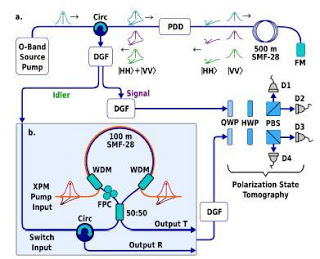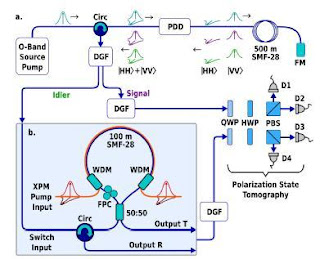(a) Entangled photon-pair source and test apparatus for ultrafast switching.
(b) The single-photon switch.
To deploy and operate a quantum network which utilizes existing telecommunications infrastructure, it is necessary to be able to route entangled photons at high speeds, with minimal loss and signal-band noise, and—most importantly—without disturbing the photons’ quantum state. Here we present a switch which fulfills these requirements and characterize its performance at the single photon level; it exhibits a 200-ps switching window, a 120:1 contrast ratio, 1.5 dB loss, and induces no measurable degradation in the switched photons’ entangled-state fidelity (less than 0.002). Furthermore, because this type of switch couples the temporal and spatial degrees of freedom, it provides an important new tool with which to encode multiple-qubit states in a single photon. As a proof-of-principle demonstration of this capability, we demultiplex a single quantum channel from a dual-channel, time-division-multiplexed entangled photon stream, effectively performing a controlled-bit-flip on a two-qubit subspace of a five-qubit, two-photon state.
In conclusion, we have demonstrated the first all-optical switch suitable for single-photon quantum communications. It achieves low-loss (< 1 dB when used to switch between transmitted and reflected modes, less than 1.7 dB when combined with a circulator), high-isolation (greater than 20 dB), and high-speed (less than 200 ps) performance without a measureable disturbance to the quantum state of the routed single photons. We demonstrate its ultrafast capability by demultiplexing a single quantum channel from a time-division-multiplexed stream of entangled photons. Very few fundamental limitations apply to this type of switch design. With carefully designed fiber components, one has the potential to dramatically reduce the switch’s loss. In principle the only unavoidable switching losses are fiber transmission losses (0.15–0.2 dB/km) and circulator insertion losses (waveguide-based circulators with a 0.05 dB insertion loss have been designed and simulated). Additionally, decreasing L to a few meters will reduce the switch’s speed to about 10 ps while simultaneously decreasing the background by an order of magnitude. Even without these improvements, however, this switch represents an important new tool for manipulating spatianlly- and temporally-encoded quantum information. Physics Review Letter abstract is here
If you liked this article, please give it a quick review on ycombinator or StumbleUpon. Thanks

Brian Wang is a Futurist Thought Leader and a popular Science blogger with 1 million readers per month. His blog Nextbigfuture.com is ranked #1 Science News Blog. It covers many disruptive technology and trends including Space, Robotics, Artificial Intelligence, Medicine, Anti-aging Biotechnology, and Nanotechnology.
Known for identifying cutting edge technologies, he is currently a Co-Founder of a startup and fundraiser for high potential early-stage companies. He is the Head of Research for Allocations for deep technology investments and an Angel Investor at Space Angels.
A frequent speaker at corporations, he has been a TEDx speaker, a Singularity University speaker and guest at numerous interviews for radio and podcasts. He is open to public speaking and advising engagements.


